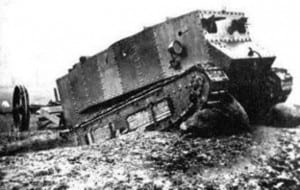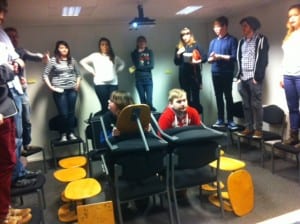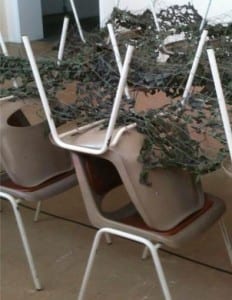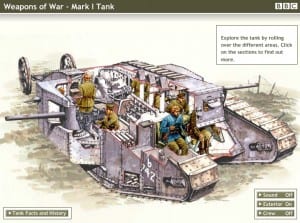One of the highlights of the tank group’s performance I think was the atmosphere we created the moment the audience walked into the room; with the rumble of the tank sound effect in the background with the monotonous chant of ‘From the blood, through the mud, to the green fields beyond.’ We created a sense of unease and tension within the audience since they did not really understand what was so far happening. Also, with the audience being cramped in right at the beginning it heightened the atmosphere because it gave them a sense of being trapped. Moreover the use of the chairs and netting, although ambiguous at first the audience soon got the idea of what we were creating, plus with the use of the netting whilst the audience would get the claustrophobic feeling we wanted, the netting still gave them some source of viewing, yet, I would have liked to experiment with restricting the audience’s view because the view inside a real tank was limited.
Moreover, the fact we used diary entries from soldiers who were in the tanks during the first world war brought a different sense of atmosphere to the performance ‘narratives provides coherence, a process of emplotment which configures these actions into a meaningful, comprehensible interpretation’ (( Postlewait, T. (1992) ‘History, Hermeneutics, and Narrativity’ in J.G Reinelt and J.R Roach (eds) Critical Theory and Performance University of Michigan Press pp. 356-368)) By using the diary entries we were bringing the piece back to the community and giving a voice back to the tank which would have otherwise not been there, plus the fact that one of the main aims of the whole safe-bet performance was to bring back the community and the voice to the grandstand. The narratives created by the use of diary entries are self-explanatory and not closed ‘but flexible and dynamic social practices, and this means that the experience of belonging to community always represents a partial account of experience’ ((Govan, Emma; Nicholson, Helen and Normington, Katie (2007) Making a Performance: Devising Histories and Contemporary Practices London: Routledge)) which shows how the audience would have understood the diary entries for actual experience and would have been able to empathetically imagine the happenings, in addition to this, the fact we used German diary extracts as well as English diary entries, we gave a balanced view point of the tank from both the victor and the victim.
However, one of the performances weaknesses was that we were still shaky with our lines, which caused some minor confusion and some delay which stopped the performance flowing fluidly. For me personally I kept rushing my lines from nerves of not fully knowing them and so I continually tripped over my lines which stopped the flow of the performance. We could have overcome this problem by rehearsing our lines more often so we could memorise them easier to make them flow better, on the other hand, we had to change our lines on the day of the performance since one of us almost did not make it due to serious illness, we had to change our lines round in order to fit this change and so on the performance we got muddled with the lines that had been cut and the new lines that had been introduced.
Another minor problem with our performance I believe was the chairs, although we had practiced placing them perfectly, the chairs can still be unpredictable and in one of our three performances one of the chairs did fall down. We could have tackled this problem by once again, practicing with the chairs more thoroughly or even choreographed the chair sequence so as to move and place the chairs perfectly so as to not let them fall down.
Another issue I think we should have addressed before the performance was the moving of the audience and the flow of the piece, the movement and scene changes were quite slow and I think we lost the energy during the scene changes as we re-positioned the audience for the next bit, also, I believe that in one scene, the dialogue was slow on delivery between us performers and it also lost some of our energy, this could also be contributed to the fact we had recently changed our lines and were still new to the new lines. We could have combated the lack of energy whilst moving the audience by maybe having some lines to say whilst the audience moved or even we could have started the different scenes earlier in order to counteract this lack of energy in the scene changes.
If we were given more time I would have liked to experiment with more ideas relating to the tank. For instance we wanted to experiment with messing with the audience’s senses. ‘The noise is horrific and the heat was very considerable, and the smell of cordite and engine exhaust fumes was pretty nasty’ ((Mark Dillon (2010) What was is like in a WWI tank? Online: http://www.bbc.co.uk/learningzone/clips/what-was-it-like-in-a-ww1-tank/12726.html (accessed 6th May 2013) )) although we had the sound effect of the tank playing throughout to give them the sense of the sound level, we only had this on low so the audience could hear our dialogue over it. We had, alternatively looked at the smell and feeling of being in a tank, we wanted to create the smell of a tank and its fumes which were not properly vented, we looked at the smell of petrol but we could not replicate the smell without using a highly flammable substance which we believed to be too dangerous. We looked at the idea of having a rag sprayed with WD40 in the corner, on the contrary we decided against this because WD40 is still highly flammable and the rag in the corner might have confused the audience to its use being there.
Furthermore, if we had more time I think we could have looked at making the audience more involved within the project, by possibly making them help us build the tank. They could have gotten a sense they were part of the creation process and understood what we were doing more closely; on the other hand, this would have taken a lot of careful planning since the chairs were tricky to place and even in our final performance one of the chairs slipped causing the tanks to collapse, if we had gotten the audience to build the tank maybe the chairs would have been more likely to collapse and we could not take that risk. Alternatively, we could have made them more involved by maybe getting them to dismantle the tank at the end, unfortunately, due to time restrictions we could not do this because we needed to get the audience back into the main room so they could see the other two performances that were similarly going on at the time.



